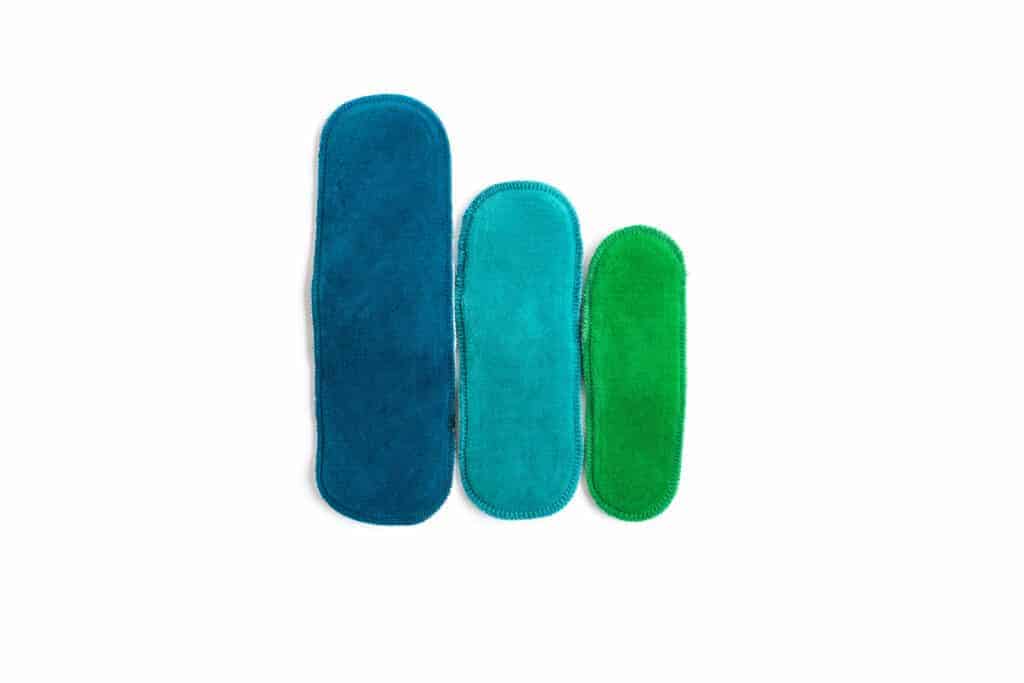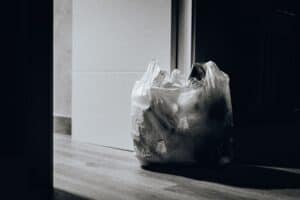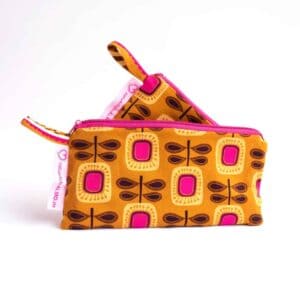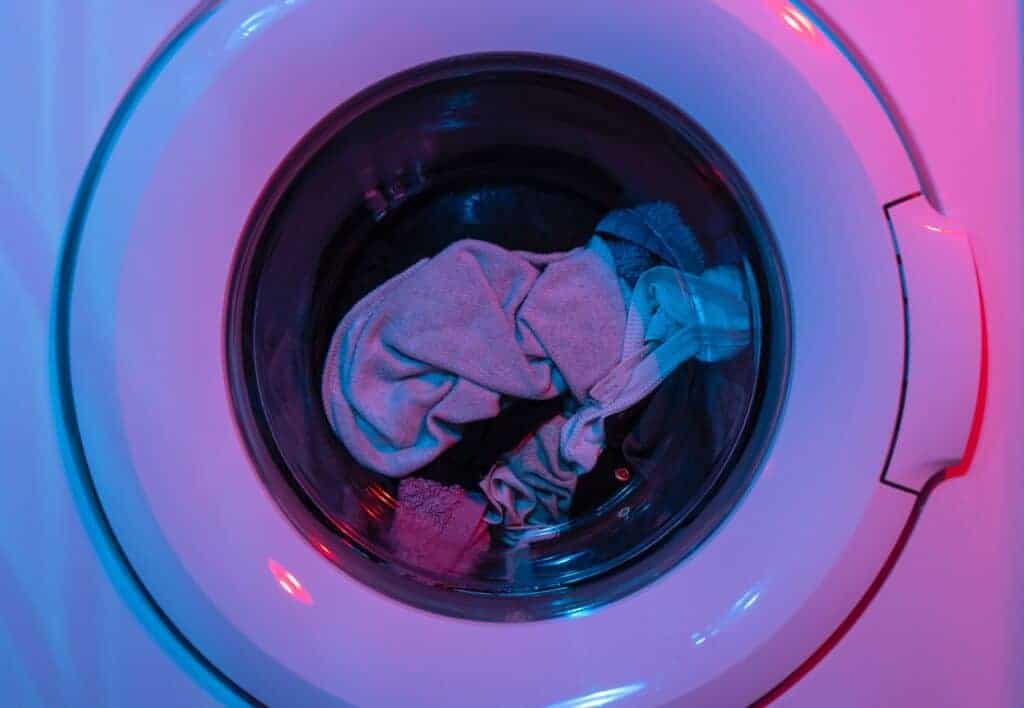Since several years now, the sustainable and reusable cloth pads and panty liners have been enjoying a well-deserved revival. For reasons of climate protection, the environment and love for their own health, more and more women are turning to cloth sanitary towels.

The history of menstrual hygiene articles and underwear protection during menstruation is long. Even in ancient times, women used the forerunners of pads and tampons. Women from all over the world made these pads and tampons themselves from many different materials. Among other things, papyrus, wood, moss, but also grass and animal skins were used.
Sanitary napkins were later sewn, initially from all sorts of scraps of fabric, then from cotton. The first cloth pad was born. The first disposable sanitary napkin came onto the market in Germany in 1894 and the Camelia company was advertising its disposable products as early as 1926. The naturally more convenient disposable products, that did not need to be washed and dried quickly, replaced the cotton sanitary napkin.

With the sanitary napkins from the beginning, the modern fabric sanitary towels of today have nothing in common except the material. But what exactly are sanitary towels and panty liners?
Cloth pads and panty liners are sustainable and reusable sanitary napkins for monthly hygiene of women. This means that they are not disposed of in the garbage after use or, in the worst case, end up in the wastewater, but are washed out like reusable baby diapers after use and can thus be used again and again.
They usually consist of many layers of absorbent ecological materials. Like many of the disposable products, also fabric sanitary towels have so-called "wings", a widening on both sides that are provided with a press button. When the push button is closed, the cloth pad is firmly fixed to the underwear. It is just as tight and reliable as the disposable pads with adhesive strips.
Cloth pads and panty liners are available in different lengths, thicknesses and shapes and in all imaginable patterns and colors. There are even variants of the cloth pads that have interchangeable inserts. So only the insert, but not the entire pad, has to be changed. The fabric sanitary towels of today are no longer inferior to the disposable sanitary towels in terms of comfort, suitability for everyday use and reliability.
Cloth pads and panty liners have several advantages. The main reasons concern the environment and women's health.
If you calculate how often a woman gets her menstrual cycle during her life, namely an average of 500 times, and has to use around 17,000 disposable sanitary towels or tampons during this time, you can quickly see the amount of waste that is generated by the disposable items during this time . In addition, there is the packaging of the sanitary napkins and tampons, since every single napkin and every single tampon is individually packed in plastic to keep them hygienically clean.

Because of this extra garbage, which additionally pollutes our environment, it is worth looking around for environmentally friendly alternatives such as sanitary napkins for menstrual hygiene. It also saves valuable resources, because disposable sanitary towels and tampons are made from cotton, for example, only to end up in the trash after being used once.
In contrast to single-use products, sanitary towels made from cotton or hemp do not contain any fragrances, chemicals or plastics. In particular, the plastic films that are used in disposable sanitary towels or panty liners can become a breeding ground for germs and bacteria. The addition of fragrances can additionally irritate the very sensitive skin in the genital area. Fungal infections or itching can result. In addition, the classic disposable sanitary towels can not be classified as particularly breathable. In the warm, humid climate that plastic creates, fungi and bacteria feel particularly comfortable and multiply accordingly quickly.
Cloth sanitary towels, on the other hand, do not require any additional fragrances and are air-permeable. The use of cotton and other breathable materials, such as hemp, ensures that the air can circulate freely and thus prevents infections, rashes, inflammation and even odor formation.
At first, the acquisition costs may seem a bit high, as a number of cloth pads - depending on how heavy the bleeding is - are required. But they are not, because the investment quickly pays for itself. Cloth sanitary napkins last for years with the right care and can be used over and over again.

The annoying monthly purchase of hygiene items is also eliminated and if the sanitary towels or panty liners are washed with the normal 60 degree laundry, they do not even cost additional electricity or washing powder.
Anyone who is skilled at using the sewing machine can make cloth bandages on her own and thus save even more money.
The comfort of the cloth pads is a positive aspect. They are cuddly soft to the skin, no plastic pinches, rubs or makes rustling noises when moving. The wings hold the sanitary napkins securely in place.
There is often a strong blood flow, especially at the beginning of the menstrual period and at night. Or is more blood to be expected because, for example, there is no suitable place to change your period panties on a long hiking tour? In those cases, this underwear in combination with a conventional sanitary napkin or menstrual cup offers double and longer protection.
Typically, high quality menstrual underwear has substances in the absorbent materials that eliminate odours, such as those caused by menstrual bleeding and blood collection. This ensures greater well-being during your period. Odor-eliminating substances are usually not used with high-quality natural fibers and organic materials. Cleaning at higher temperatures removes odors and kills all bacteria in this case.
For example, anyone who goes on long air travel or has to be satisfied with the small toilet areas in the coach will notice the inconvenience of changing panties in narrow spaces. In addition, after changing your period panties, you should pack your used panties and take them with you. Disposal is not an option here. For some women, carrying them when traveling becomes an unpleasant experience, even if an airtight transport in sealable plastic bags is not a hygienic problem. In addition, not every woman always wants to carry a spare pair of briefs with her in her handbag, which can also be easily identified as this. Creative women solve the latter inconvenience with discreet packaging. Depending on the size of the panty and the thickness of the absorbing insert, period panties can be folded down to the smallest dimensions so that they even fit in a trouser pocket.

The average prices between 20 euros and 100 euros are comparatively expensive for the purchase of the period panties if four or five panties are to be bought so that there are enough available for the duration of the menstrual period. But once bought, there are no follow-up costs and the purchase price is quickly recovered if the monthly costs for single-use products are compared to it.
In addition to the sole use for menstrual bleeding, cloth pads and panty liners can be used to support the use of menstrual sponges.
Even with slight incontinence, for example pelvic floor weakness, or with discharge, cloth pads or the thinner cloth panty liners are reliable and inexpensive helpers.
How many sanitary towels a woman needs to get started can not be answered in general. The amount depends on the length and heaviness of the woman's bleeding and how often the pads can be washed. Basically 8 to 10 cloth pads in normal size and 4 to 6 larger cloth pads are recommended for the night. Depending on whether panty liners are usually sufficient towards the end of the period, an additional 4 to 6 panty liners can be purchased.
If you are not sure whether cloth sanitary napkins are the right solution and you have doubts with regard to the financial aspect, you should only buy a few sanitary towels first and combine monthly hygiene with the classic disposable products. One advantage of this is that the actual need can be estimated later and the acquisition costs do not become too high.
Cloth pads are usually just as safe as disposable pads. Provided that, like disposable sanitary towels, they are changed in time. The right size of the pad also plays a big role. The soft core of the cloth bandages is extremely absorbent and reliably absorbs menstrual blood without leaking or becoming soggy. Nevertheless, as with the disposable sanitary towels, a little blood can run out every now and then. There is no 100% guarantee, neither for fabric nor for disposable sanitary towels.
Some suppliers of sanitary towels and panty liners have taken to heart women's concerns that sanitary towels could become soaked and equipped their sanitary towels with a thin, water-impermeable protective layer.
This protective layer usually consists of PUL. PUL - Polyurethane laminated - is a fabric coated with polyurethane. These substances are used in the medical and sanitary sectors, for example for incontinence pads for beds, for diaper fabrics or as a coating for outdoor clothing.
The thin coating of the fabrics with polyurethane is used to protect against moisture. Most people are most likely to know this coating from mattress protection pads, which are very thin but absolutely waterproof.
PUL-coated fabrics are breathable to a certain extent and can be easily washed in the washing machine without breaking the moisture protection.
At first, wearing a cloth pad may be a little unusual. But that disappears very quickly, just as quickly as the uncertainty that may exist at the beginning as to when and how often this type of sanitary napkin has to be changed. If you are trying cloth sanitary towels for the first time, you should check more often, to be on the safe side, to see how much the sanitary napkin has soaked up. Usually the sanitary napkins feel dry because, as with the disposable products, the menstrual blood "seeps" into the absorbent core. However, if it feels "damp" or "sticky" over time, it should definitely be changed as soon as possible, as the absorbent capacity of the core has been reached and the cloth pad could otherwise leak.
Cloth pads and panty liners are used in the same way as the classic disposable pads, with one difference. While the disposable sanitary napkins are attached to the underwear through a large, wide adhesive strip, cloth sanitary towels are attached to their "wings" thanks to snap fasteners. The cloth pads are placed in the underwear, the wings are placed around the undergarment bars and closed on the underside with the press button. The same principle applies to the panty liners.
As a rule, the pads are tight and reliable thanks to the snap fastener. To be absolutely sure that they really don't slip, the right underwear is extremely important.
Good cotton briefs with a wide bar are ideal. The width of the bar should be seven centimeters, so that the fabric pad has a sufficient contact surface and the fabric pad and wings fit tight to the underwear. A sufficiently firm elastic of the panty is also important. This is the only way to ensure that the underwear is secure and comfortable, and that the pas can not slip.
Another factor is the size of the pad. It should be comfortable and light to wear, not "stuffed" or "cluttered". Therefore, it is recommended that you test several sizes.
The function of a cloth pad is the same as that of a disposable pad. They absorb the issuing blood and guide it away from the body.
If you read the many good reviews and ratings on the Internet, it has been shown again and again that fabric sanitary towels have a much higher absorption capacity than conventional disposable sanitary towels. Cloth pads had to be changed much less often than you usually do with disposable pads. However, the intensity of the menstrual period also plays a major role here.
Many women still shy away from the step away from the "plastic pad" towards the sustainable cloth pad because they fear for lack of hygiene or do not find the thought of reusable pads that have to be washed particularly appetizing. It also seems so much easier to take a sanitary napkin out of its protective plastic wrap and just throw it in the trash can after use.
It's just a very small change. Experience shows that overwhelmingly most women, who have dared to take the step, are so enthusiastic about the comfort and reliability of the soft cloth sanitary towels that they no longer want to do without them.

Cloth pads can also be hygienically packed and carried in the handbag. Since they can be folded up small and discreetly, they do not take up more space than conventional, packaged disposable sanitary towels. In order to pack cloth sanitary napkins cleanly and hygienically, many suppliers offer small bags that each hold an unused sanitary napkin. If you don't want to invest in small packaging bags, you can alternatively pack the sanitary towels in small paper bags. Butter bread bags are ideal here.
Used sanitary towels are also folded up and put in waterproof but breathable bags. The suppliers of sanitary towels have a solution for this as well. Due to the folding and the breathable bag, there is no odor in the handbag and Co.
Cloth sanitary napkins can be carried with you on the go to be changed, just like disposable sanitary towels.
The sanitary towels are washed in the washing machine at 60 degrees. At this temperature, all germs are reliably killed. And hand on heart: what could be more hygienic than a cloth pad freshly washed with your favorite detergent, which smells wonderfully and is velvety soft?
What remains is the feared, so-called "disgust factor". Disposable sanitary napkins are removed from underwear after use, put in a hygiene bag or other packaging and disposed of in the bin. The same principle works with cloth sanitary towels. The push button is released, the bandage is removed, folded and disposed of in the bag. The wearer hardly ever comes into contact with the menstrual blood, even with cloth sanitary towels.
The cleaning of the sanitary towels is relatively easy, because - they simply go into the washing machine together with the other 60 degrees laundry. 60 degrees are sufficient to hygienically clean the sanitary towels and kill all germs and bacteria. Many of the sanitary napkins made of pure cotton can even handle hot laundry. However, they should not be washed individually in the washing machine, as this would negate the good sustainable advantage offered by the cloth sanitary towels.
Depending on the strengh of the bleeding, or to be absolutely sure that no stains remain, it is advisable to rinse the sanitary towels briefly in cold water after use. If there are stubborn stains, gall soap or a paste made from baking soda can work wonders. Then they are dried and kept airy until the next wash cycle is due.
Please do not use fabric softener when washing. Fabric softener can stick the fibers together over time, which reduces the absorbent properties of the pad.

If you don't want to rinse and dry the sanitary towels beforehand, you can either put them directly in the washing machine or soak them in a container with cold water, a little salt or, alternatively, a little vinegar until the next wash cycle. It is only important that the water is changed daily to prevent the formation of germs and bacteria.
After washing, the sanitary towels must be allowed to dry thoroughly before they are stored in a dust-free, airy place.
Sustainable materials such as cotton, silk or hemp are usually used for fabric sanitary towels. The outside of the pads is made of a soft fabric, the inside of an absorbent, thicker core made of natural fibers such as cotton.
The outside, i.e. the fabric that lies on the skin, comes in a different type of fabric depending on the provider. There is something for every taste, from normal, smooth cotton fabrics or hemp fabrics to terrycloth to cuddly soft velour fabric.
Cloth pads and panty liners are not only sustainable, they can also let you save money. But there are more alternatives to classic monthly hygiene. In our overview article "Alternative monthly hygiene - what is it actually" you will find further options - such as period panties or menstrual sponges.
You can find many Questions & Answers in our Frequently Asked Questions (FAQ).
Unsure about the right size? See our size chart!
Click one of the items below to get started.